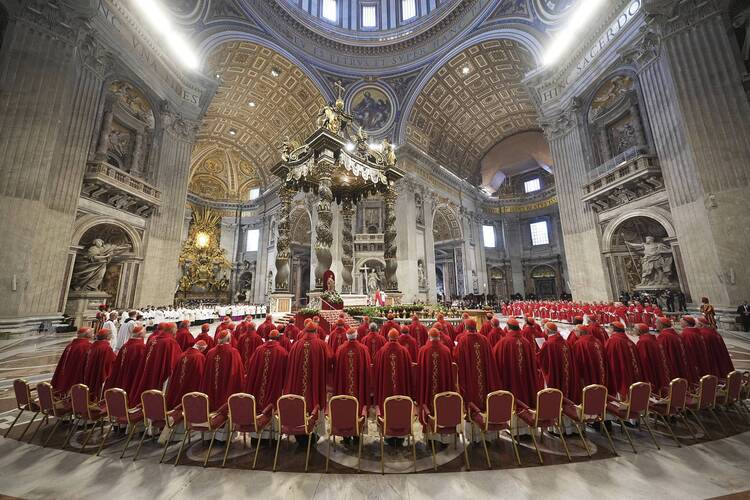A word from the editor in chief: Most of our team in Rome is staying quite near the Vatican, in a neighborhood called “Prati” just northeast of St. Peter’s Square. We also have one spot right along the Borgo Pio, blocks from the square itself, that we use as our Rome studio, pausing recording if the voices of others in the stairwell outside get loud enough to be picked up on mic. But I am staying about a mile and a half away, in a Jesuit community near the Gregorian University, which is also near the Trevi Fountain, a landmark that might be better known to many.
So each morning, I hop on a bus to make the short commute across the Tiber. As I walk from the bus stop to our temporary studio, I cross the path that has been set up for the Jubilee Year. Often, that means waiting as pilgrims, led by a cross held up high, process toward the Holy Door of St. Peter’s, praying and singing as they go.
Even as the crowd of journalists here, and so many others, begin to hold their breath for the start of the conclave, the pilgrims continue passing through the Holy Door. And with obvious exceptions for the square filling up when we see white smoke and await “Habemus papam” or for the new pope’s first Mass, the pilgrims will continue marching through the Holy Door for the rest of this year, with other pedestrians pausing as they do. As Colleen Dulle says below, no one can predict who will step out on the Loggia of Blessings, or exactly when. But we know with certainty that the day after that, pilgrims will still be walking through the Holy Door, incarnating in that path our hopes for the whole pilgrim church, continuing its journey toward God. – Sam Sawyer, S.J.
A day before the conclave, the field is wide open
By Colleen Dulle
The conclave opens tomorrow, and the energy around the Holy See Press Office is alarmingly calm.
Yesterday, it was frenetic: The cardinals added a second session of pre-conclave talks to their schedule, necessitating a second press conference at 8 p.m.; the scaffolding that was quickly erected in St. Peter’s Square is now packed with TV journalists trying not to step into one another’s shots; reporters and editors are pushing their last interviews out before the “extra omnes.” On Sunday night, ominous thunderclaps rattled the windows of Rome.
Today in the press hall, a sense of resignation: All the interviews that will be done have been done; the papabile lists are written; the unavoidable anticipation can either be channeled into frantic, anxious work or the uneasy peace of accepting one’s own powerlessness to predict or control the future. The latter seems to be winning out, perhaps because we are all already so tired.
None of us—not even the best-informed Vatican reporters, not even the cardinals—know who will emerge on the balcony or when. Nearly everyone agrees that Cardinals Pietro Parolin and Luis Antonio Tagle are entering the conclave as the leaders, but most analysts think that neither will walk in with nearly enough votes to win, possibly opening the way for a third candidate to take the lead after the first rounds of voting.
Who that third candidate could be is anyone’s guess: The lists compiled by journalists disagree, though several names pop up often: Aveline, Prevost, Zuppi, Erdo, Grech; more numerous are the names of those who could be “surprises”—no one wants to risk missing a possible “Bergoglio” candidate; that is, the cardinal who appears on few lists but emerges on the balcony anyway.
And so we wait. No one has any new information to add; no one has any confident predictions. Thankfully, Catholic tradition offers us many fruitful models for waiting: Lent, Advent, even “the life of the world to come.” The best thing we all can do now is “get our houses in order” (cf. Is 38:1-5): Prepare as best we can, watch the chimney, and pray for the cardinals inside.
Here are the other stories you need to read today:
- Tomorrow, Cardinal John Dew, the former archbishop of Wellington, New Zealand, will enter the Sistine Chapel and cast his first vote for the new pope. In an essay for America, Cardinal Dew admits he feels a little nervous—and describes how he’s praying through those nerves ahead of the conclave.
- Not everyone here in Rome came for the conclave. Some just wanted to see the Sistine Chapel, which is closed to the public ahead of the conclave. J.D. Long García spoke to tourists in St. Peter’s Square about their derailed travel plans, how they felt about Pope Francis and what they hope for in the next pope.
- Looking for a way to feel closer to the conclave, even if you’re not in Rome? The website “Adopt a Cardinal” randomly assigns you a cardinal elector to pray for as they decide who they think God would want to be the next pope.








